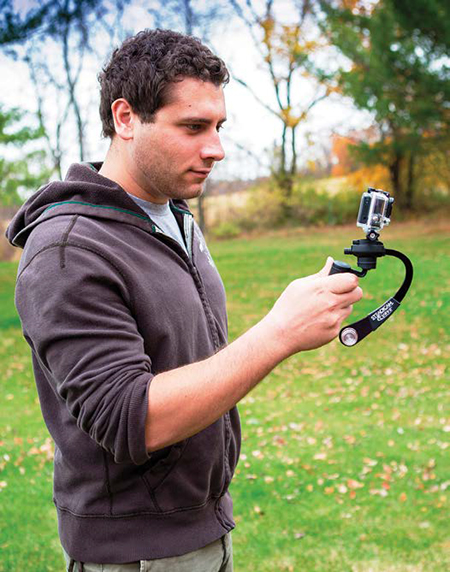Steadicam’s Curve Stabilization System
Steadicam has been around for a long time with its stabilization products. No matter what size and weight camera you have, Steadicam has a stabilization device to mate perfectly with that camera. The Tiffen Company has stepped up to the plate with the Steadicam Curve—designed specifically for the GoPro Hero.
I was a little dubious at first reviewing a stabilization device for a GoPro. The camera is minuscule and light enough that stabilization seems unnecessary. Undaunted, I thought I would give it a try.

Steadicam Curve Stabilization SystemFEATURES
The Steadicam Curve comes fully assembled right out of its small box. Looking much like its bigger brothers that handle larger cameras, the Curve has a curved frame with weights residing at the bottom. The handle attaches to the round swivel collar that allows smooth movement for the GoPro that resides on the Curve’s socket. Three different counterweights (small, medium, and large) rest in the outer weight tube to control the camera/rig balance.
The one thing that the Curve does not have is a mounting plate—this comes with the GoPro camera. (Choose the camera’s housing that best contains your fully configured GoPro Hero.)
Our GoPro Hero 3 (in its plastic enclosure and Quick Release Mount) slid into the Curve’s socket; it mounted that simply. The Curve is available in four colors: red, blue, silver and black, so you can make your visual statement that much easier.
IN USE
The first step in preparing the Curve is the same as with any stabilizer and that’s balancing the unit.
The GoPro camera itself is extremely light, so not a lot of counterweight is required. A “Quick Start Guide,” included with the Curve, explains how much counterweight to use with the Hero 1, 2 and 3 models, but you can go to http://www.tiffen.com/steadicam_curve_compatibility. html to get compatibility instructions for any GoPro Hero camera, (including the new GoPro Hero 4). The guide called for use of weights W2 and W3 (medium and small) for the Hero 3 camera that we have at the university.
I should note that even at this early stage of balancing, the GoPro was not far from being stabilized. A small red sliding lock is housed in the handle of the Curve. Moving the red switch up unlocks the handle and allows the camera to be balanced. To achieve initial balancing, the camera may need to be tilted slightly either backward or forward. In my case, the GoPro needed to be tilted slightly forward.
There’s a small knob on the back of the Curve socket that allows fine tuning of the balance. This knob is turned either clockwise or counterclockwise and the adjustment moves the entire socket forward or backward as evidenced by a mark that’s etched on the top of the Curve’s arm directly below the socket. The front to back adjustment should now be set.
The side-to-side level is adjusted by turning the outer weight right or left. This “turning” or “screwing” moves the weights left or right and the inner weights can also be moved side-to-side by placing your finger inside the tube and pushing slightly.
This entire setup took less than 10 minutes and I was now ready to test the waters.
The GoPro Hero 3 is one of our most widely used cameras whenever a student wants a wider field of view with a lightweight camera mounted on a vehicle. When I first introduced the Steadicam Curve to my cinematography class, the room filled with laughter. Those with larger hands scoffed that using their own paws alone would provide enough stabilization. I demonstrated what I learned and practiced from the quick start guide—one and two-handed operation, gripping, steering, and operating.
To everyone’s amazement (including mine), it actually worked. It does take some practice to manage something as light as the GoPro. I had the students run from one point of our studio (following a jogger) to another while keeping the subject in frame and stabilized. This took a little practice to master, but after three or four attempts with alternating the speed of the jogger and using either one- or two-handed operation of the Curve, we got great results.
We did learn two important lessons in this initial test. The first was to make sure the micro SD card, charged battery, and LCD screen were in place before using the Curve. Adding or removing anything requires rebalancing the device. Even a slight tilt forward or backward of the camera threw the balance off.
Second, as the monitor on the GoPro is so small, you need to select the widest field of view to keep your subjects in frame. I actually spent more time eyeing the level of the unit instead of trying to frame the talent. Again, bi-focaled eyes focus better on distant objects. The important thing is to balance the Curve. If something changes, you will know immediately about the imbalance as the camera does not “float.”
Last, and most obvious, the Curve really only stabilizes when shooting handheld. You don’t really need a stabilization device when the camera is attached to a vehicle, helmet, or the like.
Once you get over the minute size of the Steadicam Curve and have a specific instance when handheld stabilization is the desired mode of shooting, this tiny device could make all the difference in your end product. For its price, this is the least expensive stabilizer I’ve ever seen. Designed for use with such a small camera— one that you might think would sufficiently stabilize just by holding it—the Curve really does a better job. If you don’t mind attracting attention when using a GoPro camera, having it attached to a Curve is really icing on the cake. You might want to practice out in pubic initially without recording, as there could be a distraction; most bystanders will be gawking at the Curve.
SUMMARY
This is a stabilizer for one of the smallest cameras available. The size of the Curve closely matches and is a perfect addition to your GoPro accessories. It adds smoothness that normally only a vehicle or helmet mount could achieve and is a very useful accessory for Hero shooters.
Chuck Gloman is an associate professor and chair of the TV/film department at DeSales University. He may be contacted atchuck.gloman@desales.edu.
FAST FACTS
APPLICATION
Stabilizing GoPro camera shots
KEY FEATURES
Extremely short learning curve, fast set-up and teardown, maximizes utility of GoPro cameras
PRICE
$100, MSRP
CONTACT
The Tiffen Company
800-645-2522
www.tiffen.com
Get the TV Tech Newsletter
The professional video industry's #1 source for news, trends and product and tech information. Sign up below.
Chuck Gloman is Associate Professor with the TV/Film Department at DeSales University.

